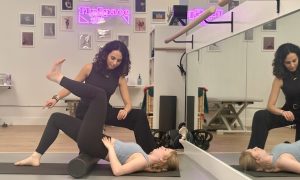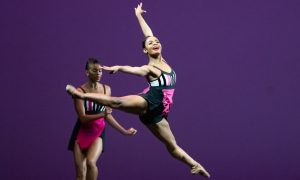I have fond memories of going to Boston Ballet School every summer, but I’ll never forget how sore and exhausted I was. We used to joke that we wished there was a magic pill to make it all easier. While there isn’t a quick fix, there are some dietary tricks that can make a powerful difference.
How many calories?
The more demanding your schedule, the more energy you need to provide the body to maintain energy levels and build muscle. “Calorie” is just a word for energy from food. Many dancers can expect to expend between 300-800 additional calories (over and above normal needs) per day during the summer compared to the regular school year. This isn’t the time to crash diet, but it also doesn’t mean that you can go eat a pint of ice cream (1,000 cal) every night because you danced all day. Use the additional calories wisely with smart choices that provide fuel, vitamins, minerals and phytonutrients that can reduce soreness.
Recovery Nutrition Tips
Even with long days, do your best to eat within one hour after exercise. This will help you refill glycogen storage tank for the next day. Glycogen is an important storage form of energy in your muscles and liver that dancers use for quick fuel for short burst combinations (like petite allegro). Post-exercise, there is this window of time in which glycogen stores are more easily filled by eating a nice mix of carbohydrates, protein and healthy fats from foods such as fruits, vegetables, beans, nuts and whole grains. Carbohydrates are your energy foods. So don’t fear getting some oatmeal, rice, quinoa or fruit, for example.
Get protein after dancing to rebuild muscle tissue. Ideally, it helps to get protein from sources that don’t contribute to increased inflammation. Harvard School of Public Health is one of the many organizations trying to increase awareness that red meat, bacon, sausage, hot dogs and other processed meats are pro-inflammatory1. Better alternatives that still provide protein would be nuts, beans, peas, lentils, seeds, soy and cold-water fish like salmon. Healthy fats are important to the nervous system, brain and the structure of every cell in your body, but be careful of following this new high-fat diet/low-carb trend that vilifies carbohydrates. Every study done on athletes consuming these fad high-fat diets show what we already knew: performance is impaired. Healthy examples of fat would be nuts, seeds, avocado and olive oil.
Nutrients for reducing muscle soreness
Antioxidants are key! The high-intensity training of a summer intensive can lead to an increased production of free radicals and oxidative stress in the body. It’s very helpful to give the body antioxidants and phytonutrients from food to reduce oxidative stress and lactic acid production from hard-working muscles. High intake (five to six servings per day) of fruits and vegetables will make a noticeable difference in how you bounce back day to day. “Whole foods, rather than capsules, contain antioxidants in natural ratios and proportions, which may act in synergy to optimize the antioxidant effect. Thus, an adequate intake of vitamins and minerals through a varied and balanced diet remains the best approach to maintain an optimal antioxidant status”2. Antioxidants are vitamins like C, E, A, beta-carotene, and phytonutrients like resveratrol, anthocyanins and polyphenols. Choose leafy greens, all fruits (especially berries), carrots and other yellow vegetables. Beets and beetroot juice can be a hard sell to dancers unaccustomed to the flavor, but they contain natural nitrates that boost performance and reduce oxidative stress. Supplements won’t give dancers the same edge of the synergistic effects of real foods.
Hydration
The first two signs of dehydration are fatigue and poor balance. Thirst doesn’t even register with the brain until you have already lost one to two liters of fluids. This level of dehydration leads to a noticeable decrease in performance and brain function. You have too much choreography to learn in a short amount of time, so make sure your large (32 ounce/1 liter) water bottle is your constant companion. Drink at least three of these large water bottles throughout the day. Drink as much as your body needs to not feel thirsty. Using thirst as a measure of how much to drink can be a good indicator, but keep in mind that the awareness of thirst can be affected by stress, nerves, food and sodium intake, so the best bet is to drink regularly throughout the day. Avoid high-sugar and high-caffeine beverages.
Supplements
The question of whether or not to bring vitamins, minerals or other supplements with you to your summer intensive is a very individual one. Consult a dietitian for your individual needs; however, there is considerable evidence to suggest that dancers are often vitamin D deficient. We all know that this vitamin plays a key role in bone health, but it also plays an important role in immune function and muscle strength, too. Inadequate vitamin D can lead to muscle weakness. Current recommendations are to get 600-1000 IU per day.
Key Strategies to Have the Best Summer Ever:
- Hydrate well before, during and after exercise.
- Consider taking a vitamin D if you’re inside all day.
- Never skip breakfast.
- Bring snacks with you to keep energy levels consistent.
- Eat dinner within 30 minutes to one hour post-exercise.
- Fruits and vegetables will help reduce oxidative stress and soreness.
- Plant-based proteins like beans, lentils, peas, nuts, seeds, grains and soy provide plenty of amino acids for muscle rebuilding but aren’t as likely to contribute to inflammation as red meat.
 By Emily C. Harrison MS, RD, LD of Dancer Nutrition.
By Emily C. Harrison MS, RD, LD of Dancer Nutrition.
Emily Cook Harrison MS, RD, LD
Emily is a registered dietitian and holds both a bachelor’s and master’s degree in nutrition from Georgia State University. Her master’s thesis research was on elite level ballet dancers and nutrition and she has experience providing nutrition services for weight management, sports nutrition, disordered eating, disease prevention, and food allergies. Emily was a professional dancer for eleven years with the Atlanta Ballet and several other companies. She is a dance educator and the mother of two young children. She now runs the Centre for Dance Nutrition and Healthy Lifestyles. She can be reached at emily@dancernutrition.com
www.dancernutrition.com
Sources:
- Foods That Fight Inflammation. Harvard Health Publications. Pub 2015. www.health.harvard.edu/staying-healthy/foods-that-fight-inflammation
- Pingitore A, Pereira GP, Mastorco F, Quinones A, Iervasi G. Vassalle C. Exercise and oxidative stress: Potential effects of antioxidant dietary strategies in sports. Nutrition. 2015.















